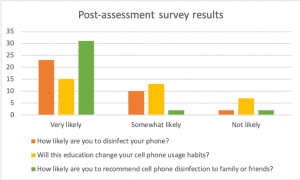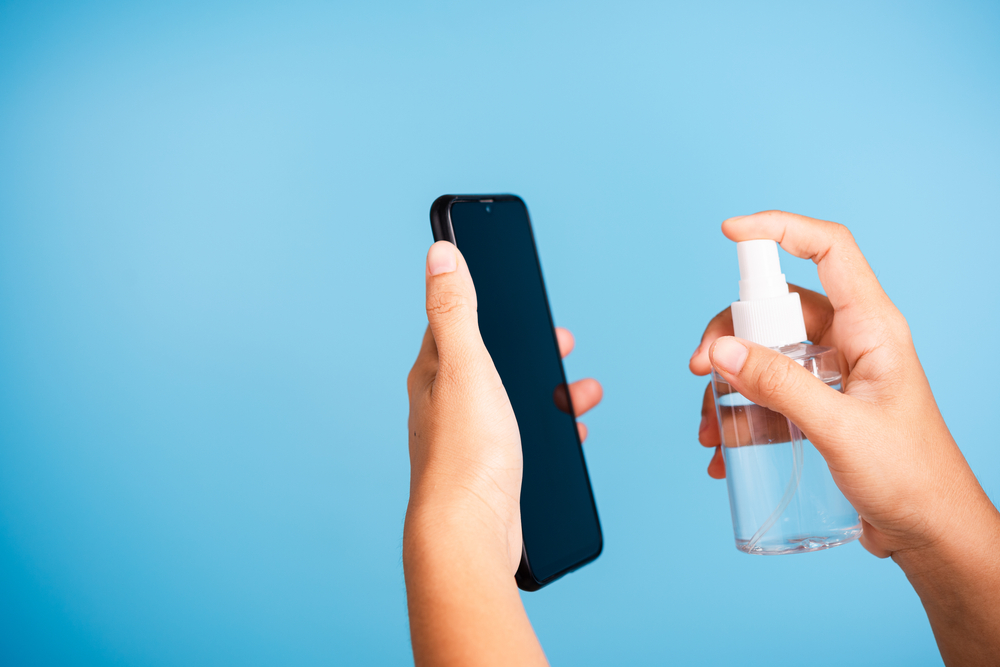Nurse-led, evidence-based education fills knowledge gap.
Takeaways:
- All smartphones and other mobile devices are hosts to a variety of bacterial contaminants.
- A lack of education about smartphone disinfection exists in healthcare.
- Smartphone disinfection methods can reduce the potential transmission of bacteria.
I’m a nurse. At 5 am the alarm goes off on my smartphone sitting on the nightstand. I grab it and head into the bathroom to check the weather and email. Next, it’s off to the kitchen, where I use my phone to scroll for a new dinner recipe. My preschooler, who has a cold, plays a game on my phone before we head out the door. At work, I go to the cafeteria for a coffee. With my hands full, I place the phone on the counter as I reach for money in my pocket. After paying the cashier, I pick up the phone and head off to see my first patient. In just a few hours, my smartphone has been exposed to numerous germs. Each time I handle my phone or place it on a surface, it picks up another contaminant. (See What’s on your phone?).
In the course of the day, our mobile devices are exposed to thousands of contaminants. These are the most common contaminants found on smartphones:
- Coagulase-negative staphylococci
- Clostridium difficile
- Corynebacterium
- Escherichia coli
- Pseudomonas aeruginosa
- Yeast
A world of touch
The average smartphone (more than 90% of Americans own one and use it personally and professionally) is touched 2,600 times a day. Our fast-paced lives likely place smartphone disinfection low on our list of priorities, but our increasing dependence on these devices, especially in the healthcare environment, requires that we discuss smartphone cleanliness and habits.
Smartphones are seen throughout hospitals—from an attending talking to a patient while looking up lab results on her phone to a nurse using his phone as part of patient educating at the bedside. These daily scenes sparked our interest in exploring what the literature says about the prevalence of phone contamination, if healthcare professionals disinfect their phones, and whether bacteria from phones can increase the risk of healthcare-associated infections (HAI).
Where has your smartphone been today? Has it been dropped on the floor? Have you taken it into the bathroom? Has it been in small children’s hands? Have you carried it into patient rooms? Asking these questions will help increase your awareness of the germs lurking on your phone. They inspired us to launch a project to raise nurses’ awareness of smartphone contamination and take steps to reduce it.
Disinfect to improve patient safety
To improve patient safety, we need to understand the prevalence of HAIs and how they affect patients and hospitals. The Centers for Disease Control and Prevention (CDC) reports that one in 31 hospital patients acquire an HAI, about one-third of which are caused by nonadherence to established infection-prevention practices such as hand hygiene. The CDC also notes that surfaces contribute to HAI transmission. Smartphones are frequently touched surfaces, and studies reviewed by Beckstrom and colleagues indicate that essentially all unsanitized smartphones demonstrate bacterial growth, making them potential transmission vectors, transferring germs to and from the hands, face, and mouth.
Nurses may inadvertently put themselves and patients at risk by using contaminated smartphones. However, with education and increased awareness, we can act as role models and advocates to demonstrate smartphone cleanliness.
Gap in knowledge
A lack of education and standardized processes for disinfecting smartphones exists in healthcare, so the goal of our project was to bring attention to the contaminants entering and leaving the hospital on the smartphones we carry. We conducted an evidence-based educational campaign on smartphone contamination and disinfection for staff (including nurses, physicians, and ancillary personnel) and visitors in our acute-care hospital. The campaign included short sessions that introduced information on the prevalence of smartphone bacterial contamination and demonstrated three cleaning methods to reduce contaminants. We reminded participants of the times and places they would normally be handling their phone throughout a typical day and educated them about how their hands can pick up bacteria and inadvertently contaminate the surface of the phone. Participants learned about how organisms can be transmitted from their phones to people and items in their home and work environments, including patients and family members.
In an assessment survey at the end of the educational sessions, 100% of participants said the sessions were very interesting. Here are some of their comments:
- “Wow! Now I know why I’m sick all the time. The germs are all over my phone!”
- “I never would have considered my phone being dirty.”
- “My husband always has his phone in the bathroom. That’s going to stop!”
Only after the educational sessions did we realize the magnitude of the lack of understanding of smartphone contamination. We found minimal difference in knowledge deficiency between healthcare workers and hospital visitors. (See Changing habits.)
In a post-assessment survey, we asked participants (healthcare staff and hospital visitors) if the educational sessions changed their smartphone (cell phone) use and disinfection practices.


Smartphone disinfection tips
Options for disinfecting smartphones include commercial wipes, alcohol and water solutions, and personal UV-C (ultraviolet light in the 200 to 280 nanometer range) devices. (See Effective methods for disinfecting smartphones.) In addition, these tips can help keep your phone clean:
- Remember that your case is a part of your phone surface. Placing a dirty case on a clean phone negates the benefits of disinfection.
- Don’t take your phone into the bathroom.
- Avoid using your phone while eating.
- Make cleaning your phone a daily habit (for example, always do it right before bed).
- Wash your hands frequently. Clean hands mean a cleaner phone.
Hanging up on germs
Nurses play a crucial role in educating and increasing awareness about infection prevention for smartphone users, and we’re leaders and advocates for demonstrating appropriate techniques and behaviors for championing the safety and well-being of the patients we serve. Smartphone disinfection awareness not only has a positive impact on patient safety and health, but it also can decrease HAI occurrence and related hospital costs and increase patient and employee satisfaction. Acknowledging this topic as a priority for healthcare teams can lead to policies, practices, and additional research to guide practice.
Consider these three options for disinfecting your smartphone and other devices.
| Method | How it’s used (follow cleaning product manufacturers’ recommendations) | Advantages | Disadvantages |
| Commercial wipes (only bleach-containing wipes will kill certain organisms, such as Clostridium difficile) | · Wring out excess moisture from the wipe. · Wipe entire surface of the device. · Allow the designated amount of dwell time/contact time. · Allow the device to air dry completely. | · Easily accessible · Readily available · Convenient · Time efficient | · Potential for moisture to enter device · May scratch touch screen surface if wipe is abrasive · Missing surface area can contaminate other parts of device |
| Alcohol and water solution (60% alcohol/40% water) | · Apply solution to a damp cloth. · Wipe the entire surface of the device. | · Inexpensive · Convenient · Time efficient | · Incorrect mixing leads to ineffectiveness · Potential for moisture to enter device · Missing surface area can contaminate other parts of device |
| Personal UV-C (ultraviolet light in the 200 to 280 nanometer range) sanitizing unit | · Place device in the unit. · Turn on the unit. · Remove the device when the unit prompts you. | · Kills 99.9% of germs · User friendly | · Costly (ranges between $30 and $100) · Time (takes about 20 minutes to disinfect) |
This project demonstrated how a nurse-driven, evidence-based educational campaign on smartphone disinfection can help promote awareness of the issue and create workable solutions. Changing smartphone behavior may be challenging, but small changes can make a big difference in patient outcomes. All of us must be mindful of the germs living on our smartphones and understand that germ-free is the way to be.
The authors work in the department of nursing at the University of Hartford in West Hartford, Connecticut. Lorie Lund, Suhaila Binyameen, and Elyse Inferrera are graduate assistants. Karen Breda and Susan Eichar are associate professors.
References
Beckstrom AC, Cleman PE, Cassis-Ghavami FL, Kamitsuka MD. Surveillance study of bacterial contamination of the parent’s cell phone in the NICU and the effectiveness of an anti-microbial gel in reducing transmission to the hands. J Perinatol. 2013;33(12):960-3.
Centers for Disease Control and Prevention. Healthcare-associated infections: HAI data. October 5, 2018. cdc.gov/hai/data/index.html
Kirkby S, Biggs C. Cell phones in the neonatal intensive care unit: How to eliminate unwanted germs. Adv Neonatal Care. 2016;16(6):404-9.



















1 Comment.
Yes,IAgree 100%
GOD BLESS ANA HOPEFULLY I WILL COVER AND SHARE IT WITH DIFFERENT HCW AS WELL COMMUNITIES MILLION THANKS .
HAPPY NEW YEAR BEST WISHES FOR NURSES WORLD WIDE WISH WORLD FREE OF COVID-19??❤
NAHLA SULEMAN
RN-CCRN
COVID-19 TOT
SUDAN